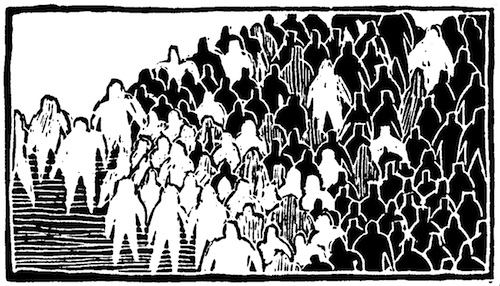The link between trade and population
 The relationship between trade and population is based on one main factor: growth. Growth of people, growth of goods and services, and growth of markets and capital.
The relationship between trade and population is based on one main factor: growth. Growth of people, growth of goods and services, and growth of markets and capital.
The latest population projection from the United Nations is for a world population of 8.1 billion people by 2025, and 9.6 billion by mid-century. That translates into a lot of consumers, especially as more developing countries rise into the middle class.
Consumption run amok
More consumers mean more markets, which results in a big push for global trade agreements. Historically, free trade has not trickled down and helped regular people and communities (see the North American Free Trade Agreement). It helps corporations, lobbyists, and some government officials; in other words, mainly the 1%.
Come to a free screening of "Mother: Caring for 7 Billion," a film that highlights the humanitarian and environmental crises created by the world's population growth, at 6:30 p.m. Sept. 10 RESCHEDULED TO September 17 at Covina Public Library, 234 N. Second Ave., Covina. For more information, contact Joan Holtz at (626) 443-0706.
Trade policies have led to extensive environmental degradation, especially in developing nations. Trade agreements also increase poverty and result in the displacement of citizens who are often forced to leave their homeland in search of livelihoods. Instead of pursuing global trade that benefits the 1%, trade policies should be fair and protect workers and families. And policies should discourage the displacement of families by corporations who confiscate land to gain access to natural resources which are exploited for corporate profit.
Instead the focus should be on fair trade and improving the rights and lives of people and communities, and ensuring a healthy environment. Stabilizing population growth is needed, as well as reducing inequality around the world, supporting universal health and family planning services, and providing girls and women more education and social/economic opportunities.
The role of the Trans-Pacific Partnership
If you’ve never heard of the Trans-Pacific Partnership (TPP), you are not alone. The TPP is a major international trade and investment agreement pushed by the United States behind closed doors. It is currently being negotiated between the United States, Australia, Brunei Darussalam, Canada, Chile, Malaysia, Mexico, New Zealand, Peru, Singapore, Vietnam, and Japan (eventually China and Russia could join). This covers approximately 40% of the global economy.
Despite the agreement’s potential reach, there has been no public input since negotiations began in 2009 – some 600 corporate advisors have access to the text, while the public, congressional representatives, journalists, and civil society are excluded. Why the secrecy?
According to the Sierra Club and other environmental organizations, the TPP could increase dirty fracking and carbon emissions; put sensitive ecological areas at risk; and increase natural gas and electricity prices, impacting consumers, manufacturers, workers, and increasing the use of dirty coal power. And it impacts public health, essential services, domestic jobs, food safety and much, much more.
Free trade agreements, with a focus on investors and not people, thrive in places with few or non-existing human rights and environmental regulations, or health standards. In a world of 7.2 billion people, rights and regulations need to be strengthened, not weakened, and access to health and community services improved.
Beyond overconsumption
At the most basic level, it boils down to consumption, much of it unsustainable. Our global economic system is predicated on ever more growth, which means more consumers. A world of over 9 billion people? Great! Food insecurity, finite resources, depleted oceans, who cares? Just buy more stuff.
More people are realizing that well-being and happiness are more important to life than non-essential consumer goods. That is anathema to the global economic system and the concept behind free trade agreements.
To learn more about the TPP and how to move from free to fair trade, check out this activist toolkit and educational materials by Global Trade Watch.
Graphic illustration by Sharon Williams
Suzanne York is on the Sierra Club's Trade Team and Global Population Committee and a senior writer with the Institute for Population Studies.



Add new comment